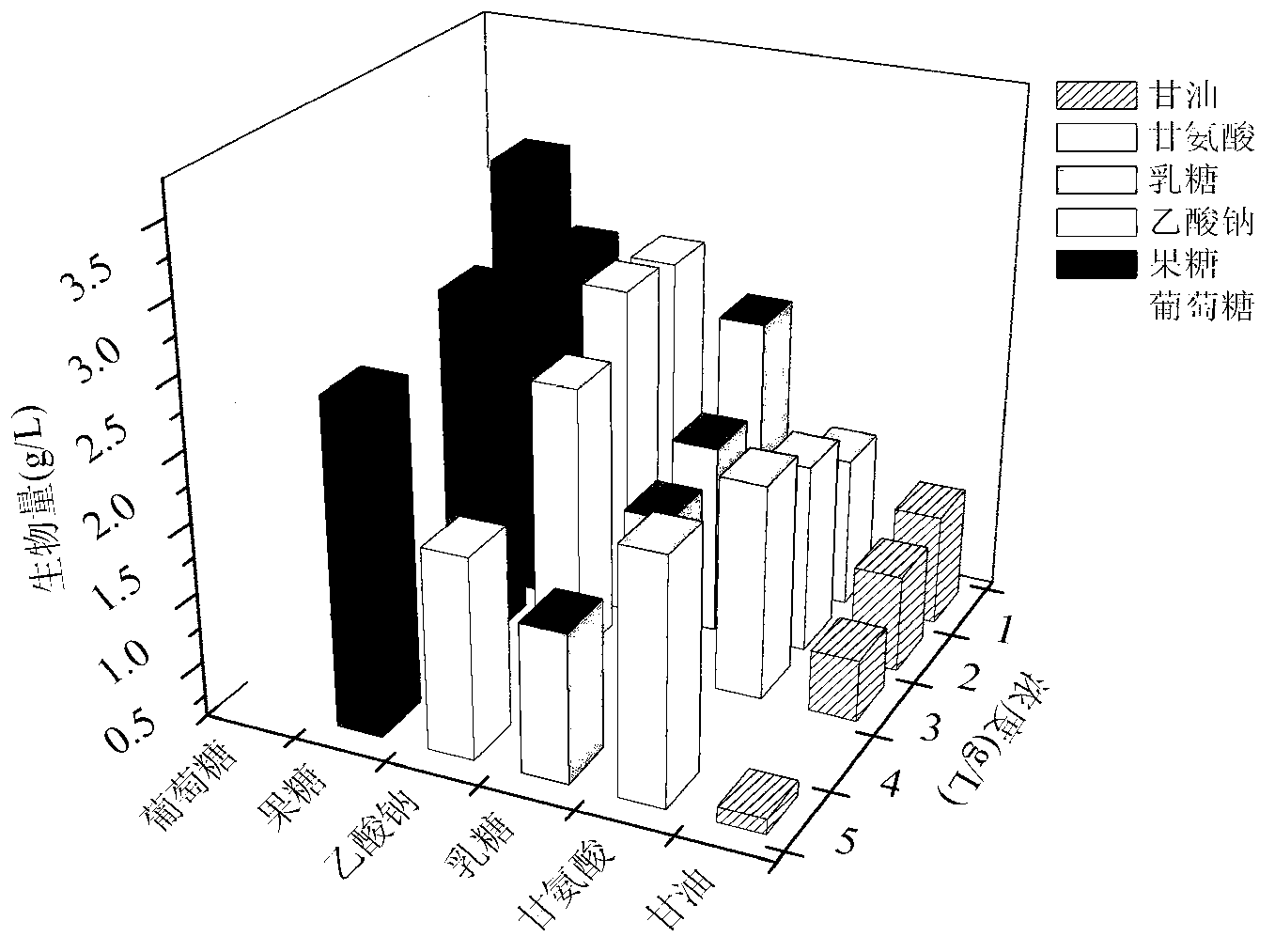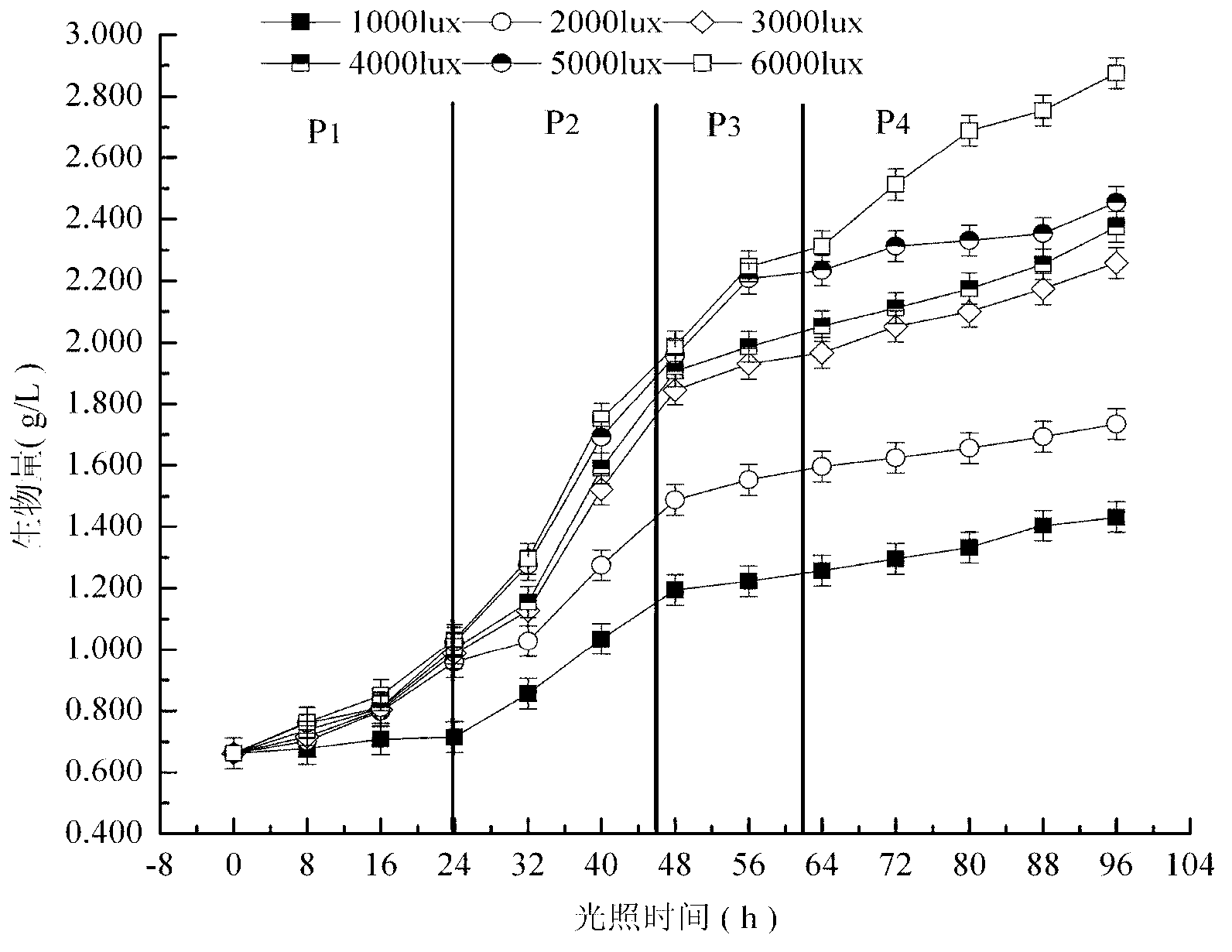Economic and efficient spirulina platensis mixed culture method
A high-efficiency technology for Spirulina platensis, applied in the field of polyculture of Spirulina platensis, can solve the problems of cost and effective utilization rate bottleneck, unfavorable growth and fixation of microalgae, low availability of microalgae, etc., and achieve fast carbon fixation Efficiency, waste reduction, and simple equipment
- Summary
- Abstract
- Description
- Claims
- Application Information
AI Technical Summary
Problems solved by technology
Method used
Image
Examples
Embodiment 1
[0014] Embodiment 1 cultivates Spirulina platensis with photoautotrophy, heterotrophy and mixed culture respectively
[0015] The Spirulina platensis cultivated to the logarithmic phase was selected under batch culture conditions, and the biomass, chlorophyll a content, organic carbon (TOC) and Inorganic carbon (IC) content.
[0016] Photoautotrophic conditions: Under photoautotrophic conditions, the light intensity is 3000 Lux, the photoperiod is 16 / 8, and CO with a concentration of 10% is introduced in the form of bubbling during the light time 2 , the gas velocity is 0.2vvm, the aeration time is 30min / d, and the medium is Zarrouk medium.
[0017] Heterotrophic conditions: Add glucose at an initial concentration of 1 g / L to Zarrouk medium without light.
[0018] Mixed culture conditions: add glucose with an initial concentration of 1g / L to Zarrouk medium, and the light and aeration conditions are the same as the photoautotrophic conditions.
[0019] As shown in Table 1, u...
Embodiment 2
[0025] The influence of different carbon sources on the growth of Spirulina platensis during embodiment 2 polyculture
[0026] Glycerol, glycine, lactic acid, sodium acetate, fructose and glucose were added to the Zarrouk medium respectively, and the concentration range was 1-5g / L. like figure 1 As shown, acetate, fructose and glucose can be used as organic carbon sources in the mixed culture of Spirulina platensis, which can significantly promote the growth of algae cells; in addition, glycine and lactose can also promote the growth of cells to a certain extent. The effect of glucose and fructose is better than that of lactose, probably because the former two are monosaccharides, and lactose is a disaccharide, and the hydrolysis and assimilation of the latter requires a certain amount of time and energy; the effect of glucose is better than that of acetate, which may be due to Glucose yields more energy than sodium acetate (2.8 kJ / mol for glucose versus 0.8 kJ / mol for sodium...
Embodiment 3
[0027] Embodiment 3 Optimizing the light intensity in the polyculture growth process of Spirulina platensis
[0028] On the basis of ensuring the biomass, optimize the light intensity during the mixed growth of Spirulina platensis. During the whole mixed culture process of this experiment, the growth curve of Spirulina platensis can be divided into four stages: (1) The first stage (P1), 0-24h; (2) the second stage (P2), 24-48h; (3) the third stage (P3), 48-64h; (4) the fourth stage (P4), 64- 96h.
[0029] like figure 2 , image 3 As shown, in the first stage, when the concentration of algae cells is low, the algal biomass under the treatment of 2000, 3000, 4000, 5000 and 6000Lux is equivalent, which is higher than that under the treatment of 1000Lux, which is 0.7g / l. This can be explained as, Under the low algae density, the light intensity is too low to satisfy the growth of algae under the treatment of 1000Lux, and the light intensity under the treatment of 6000Lux leads...
PUM
 Login to View More
Login to View More Abstract
Description
Claims
Application Information
 Login to View More
Login to View More - R&D Engineer
- R&D Manager
- IP Professional
- Industry Leading Data Capabilities
- Powerful AI technology
- Patent DNA Extraction
Browse by: Latest US Patents, China's latest patents, Technical Efficacy Thesaurus, Application Domain, Technology Topic, Popular Technical Reports.
© 2024 PatSnap. All rights reserved.Legal|Privacy policy|Modern Slavery Act Transparency Statement|Sitemap|About US| Contact US: help@patsnap.com










